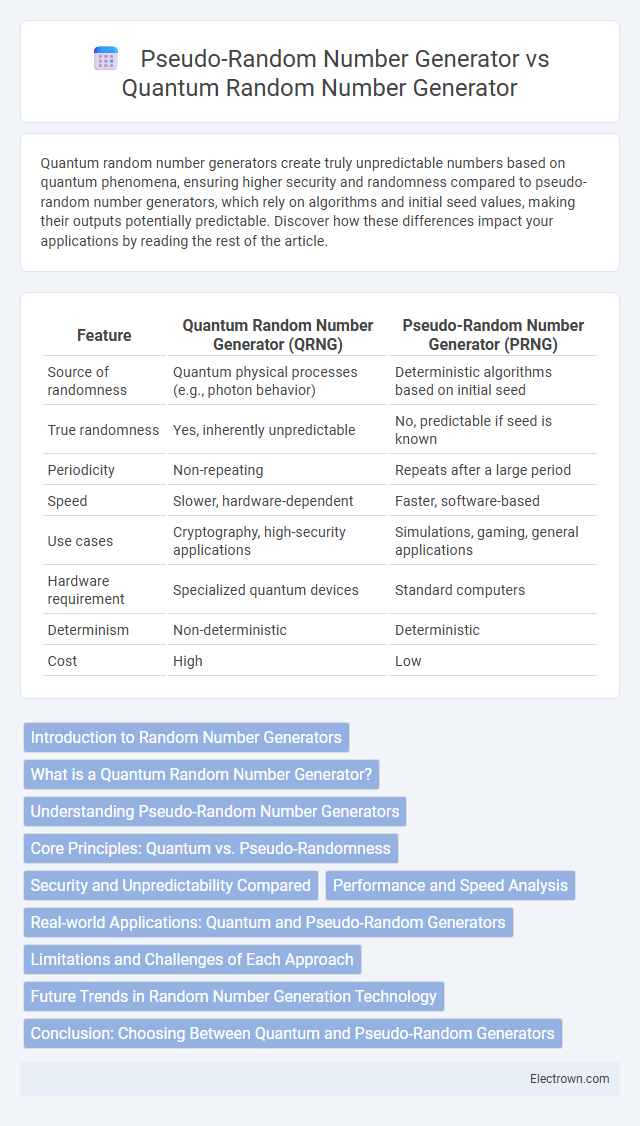Quantum random number generators create truly unpredictable numbers based on quantum phenomena, ensuring higher security and randomness compared to pseudo-random number generators, which rely on algorithms and initial seed values, making their outputs potentially predictable. Discover how these differences impact your applications by reading the rest of the article.
Table of Comparison
| Feature | Quantum Random Number Generator (QRNG) | Pseudo-Random Number Generator (PRNG) |
|---|---|---|
| Source of randomness | Quantum physical processes (e.g., photon behavior) | Deterministic algorithms based on initial seed |
| True randomness | Yes, inherently unpredictable | No, predictable if seed is known |
| Periodicity | Non-repeating | Repeats after a large period |
| Speed | Slower, hardware-dependent | Faster, software-based |
| Use cases | Cryptography, high-security applications | Simulations, gaming, general applications |
| Hardware requirement | Specialized quantum devices | Standard computers |
| Determinism | Non-deterministic | Deterministic |
| Cost | High | Low |
Introduction to Random Number Generators
Quantum random number generators (QRNGs) harness quantum mechanics principles to produce truly unpredictable and non-deterministic numbers, offering superior randomness compared to pseudo-random number generators (PRNGs), which rely on algorithms and initial seed values. PRNGs, while efficient and reproducible for simulations and cryptographic applications, ultimately produce sequences that can be predicted if the seed is known. For your security and computational tasks demanding high unpredictability, QRNGs provide a fundamentally more robust source of randomness.
What is a Quantum Random Number Generator?
A Quantum Random Number Generator (QRNG) harnesses inherent quantum mechanical properties, such as photon polarization or electron spin, to produce true randomness that is fundamentally unpredictable. Unlike Pseudo-Random Number Generators (PRNGs), which rely on deterministic algorithms and initial seed values, QRNGs generate entropy from quantum processes ensuring non-reproducible random numbers. This intrinsic quantum unpredictability makes QRNGs crucial for cryptographic applications and advanced simulations requiring provable randomness.
Understanding Pseudo-Random Number Generators
Pseudo-random number generators (PRNGs) use deterministic algorithms and initial seed values to produce sequences of numbers that appear random but are inherently predictable. These sequences can be replicated if the seed is known, which limits their security and unpredictability in cryptographic applications. Understanding PRNGs helps you recognize their efficiency and limitations compared to true randomness generated by quantum random number generators (QRNGs).
Core Principles: Quantum vs. Pseudo-Randomness
Quantum random number generators rely on the inherent unpredictability of quantum mechanics, such as the measurement of photon polarization or electron spin, to produce truly random outcomes. Pseudo-random number generators use deterministic algorithms seeded with initial values to generate sequences that only appear random but can be reproduced. Quantum randomness is non-deterministic and irreproducible, whereas pseudo-randomness depends on computational processes and can be predicted if the algorithm and seed are known.
Security and Unpredictability Compared
Quantum random number generators (QRNGs) leverage the inherent unpredictability of quantum phenomena to produce truly random sequences, making them highly secure against predictive attacks. Pseudo-random number generators (PRNGs), however, rely on deterministic algorithms and initial seeds, which can be reverse-engineered, compromising security in cryptographic applications. The non-deterministic nature of QRNGs ensures superior unpredictability and stronger protection for encryption keys compared to PRNGs.
Performance and Speed Analysis
Quantum random number generators (QRNGs) leverage inherent quantum phenomena to produce truly random sequences, offering superior unpredictability compared to pseudo-random number generators (PRNGs) that rely on deterministic algorithms. While PRNGs excel in speed and computational efficiency, often generating millions of numbers per second suitable for real-time applications, advanced QRNG devices have improved to deliver high-throughput outputs with comparable performance. Your choice between QRNG and PRNG hinges on balancing the need for genuine randomness against the demand for rapid number generation, especially in cryptographic or simulation workflows.
Real-world Applications: Quantum and Pseudo-Random Generators
Quantum random number generators (QRNGs) provide true randomness based on quantum phenomena, making them ideal for high-security applications such as cryptography, secure communications, and quantum key distribution. Pseudo-random number generators (PRNGs) rely on deterministic algorithms suitable for simulations, gaming, and general computing tasks where speed and reproducibility are prioritized over absolute randomness. QRNGs excel in scenarios demanding unpredictability and resistance to predictability attacks, whereas PRNGs remain preferred for applications requiring high throughput and consistency.
Limitations and Challenges of Each Approach
Quantum random number generators (QRNGs) provide true randomness by exploiting quantum phenomena but face challenges such as hardware complexity, high costs, and sensitivity to environmental noise that can affect reliability. Pseudo-random number generators (PRNGs) are computationally efficient and widely used, yet their deterministic algorithms make them vulnerable to predictability and unsuitable for cryptographic applications requiring high entropy. Your choice depends on balancing the QRNG's unparalleled randomness quality against the PRNG's practicality and speed for specific applications.
Future Trends in Random Number Generation Technology
Quantum random number generators harness the inherent unpredictability of quantum phenomena to produce truly random sequences, offering superior security for cryptographic applications compared to pseudo-random number generators that rely on deterministic algorithms. Future trends indicate increasing integration of quantum hardware with classical systems, enhancing encryption standards and enabling more robust simulations in scientific research. Your data security and computational accuracy will benefit from advancements in hybrid quantum-classical random number generation technologies, which aim to overcome current scalability and speed limitations.
Conclusion: Choosing Between Quantum and Pseudo-Random Generators
Quantum random number generators (QRNGs) produce truly unpredictable numbers by harnessing quantum phenomena, ensuring superior randomness essential for high-security applications like cryptography. Pseudo-random number generators (PRNGs), relying on deterministic algorithms, offer speed and reproducibility but lack absolute unpredictability, making them suitable for simulations and less critical tasks. Selecting between QRNGs and PRNGs depends on the application's security requirements, with QRNGs preferred for cryptographic protocols and PRNGs often adequate for general computational use.
quantum random number generator vs pseudo-random number generator Infographic

 electrown.com
electrown.com